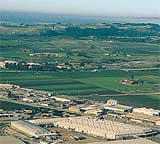Mission Foods
Location: Rancho Cucamonga
Type: One-storey concrete tilt-up building
Size: 309,000 sq. ft. total
Year Built: 1995 Website: http://www.missionfoods.com Source: Adapted from an Energy Design Resources case study Company Information
Mission Foods is the largest manufacturer of corn and flour tortillas in the world. Founded in 1977 in California, Mission Foods operates 19 production facilities across the country, including five in California.  Aerial view of S. Martinelli & Company and the surrounding area in Santa Cruz County. Photo courtesy of S. Martinelli & Co.View Details. Aerial view of S. Martinelli & Company and the surrounding area in Santa Cruz County. Photo courtesy of S. Martinelli & Co.View Details.
Sales growth over recent years has driven Mission Foods to expand rapidly, building one to two new production facilities each year. In 1995, approved plans for a new production facility in Rancho Cucamonga, California that would process corn and flour tortillas and fried products. The resulting highbay facility is a one-storey concrete tilt-up building that measures 309,000 sq. ft. - 50,000 sq. ft. serves as administrative space (two-stories), 125,000 sq. ft. for manufacturing and production, and 134,000 for warehouse space. When compared to standard base case, the energy-efficient design of the Rancho Cucamonga facility saves Mission Foods about $315,000 per year in energy costs and reduces energy use by approximately 3,800,000 kilowatt-hours.
Design and Construction
During an early planning meeting with Southern California Edison, local utility representatives encouraged Mission to consider participating in the Savings by Design program that helps owners improve the energy efficiency of new and renovated non-residential buildings. Savings by Design offers design assistance as well as financial incentives for owners and design teams. Despite initial concerns that extra time spent designing energy-efficient features would delay fast-track construction plans, Mission agreed to enroll in the program.
The design team identified process equipment and refrigeration as the two largest energy loads. The heating, ventilating, and air conditioning (HVAC) system was also targeted, since production releases large amounts of heat into ambient work space, which must then be mechanically cooled and vented. To improve energy efficiency, the design team chose to reduce space-cooling loads and optimize HVAC operations.
Reducing Space-Cooling Loads
Lighting Systems
Energy-efficient lighting was one feature chosen to reduce space-cooling loads. T8 fluorescent lamps with electronic ballasts are installed throughout administrative areas, with motion sensors that shut off lights when offices are unoccupied. In manufacturing areas, skylights provide daylighting, which supplements the electric lighting system. Building Envelope
Window glazing was another feature installed to manage cooling loads. Low-emissivity glazing on windows in the administrative areas and on skylights partially blocks solar heat gain without affecting the amount of daylight available. Premium efficiency motors
Mission invested in premium motors for process equipment, as well as inverter drives and soft starts, an electronic control system that boosts power to a motor at start-up, yet reduces energy use and helps protect against equipment wear.
Optimized HVAC System
Evaporative Cooling Instead of Mechanical Cooling
To take advantage of Rancho Cucamonga's relatively dry climate, evaporative pre-coolers are installed on air handling units that reduce the temperature of outside air being entering the system. Evaporative coolers, also commonly referred to as "swamp" coolers, work by drawing air through moist pads; air is cooled as the moisture evaporates. As such, evaporative coolers work best in hot, dry climates where humidity won't dampen effectiveness. Because no mechanical cooling is used, evaporative coolers are more energy efficient than condensers or chillers. With high average temperatures and low humidity, Rancho Cucamonga is ideally suited for evaporative cooling. At Mission, manufacturing areas need at least 50 percent outside air for health and safety. With precoolers, the chilled water plant does not need to work as hard to satisfy indoor air requirements. Evaporative coolers are also used to condition air in manufacturing support areas, further reducing mechanical cooling loads. Premium Efficiency Motors and Variable Speed Drives
Mission invested in premium efficiency motors and variable speed drives (VSD) for air handlers and pumps. In administrative and support areas, VSDs were installed in place of inlet vanes so that equipment runtimes could be matched to actual cooling and heating loads. VSDs were also installed on air handlers serving the packaging areas and a chilled water pump. One energy efficiency measure that was studied and recommended, but not originally implemented due to first-cost restrictions, was the addition of a VSD to the screw compressor serving the central plant chiller. This feature is now being added to allow for more effective modulation of the chiller capacity.
|



